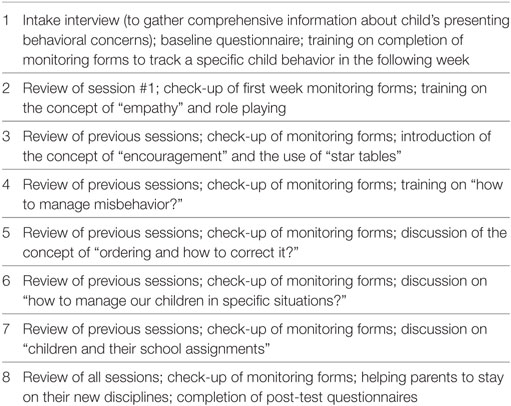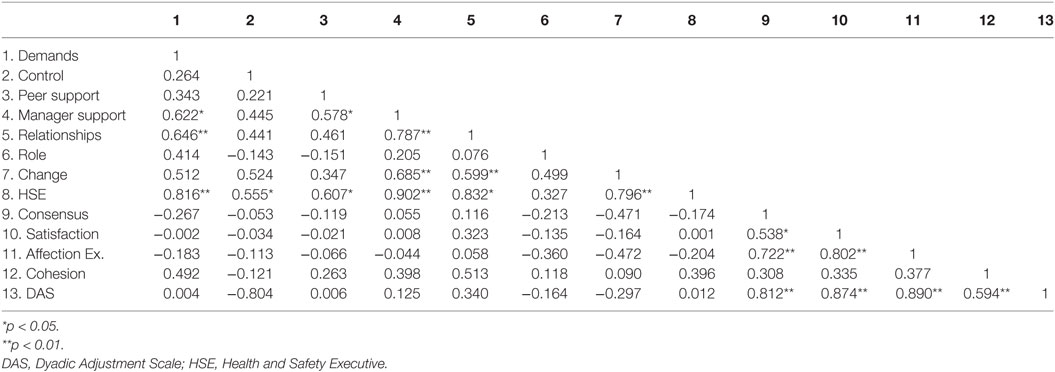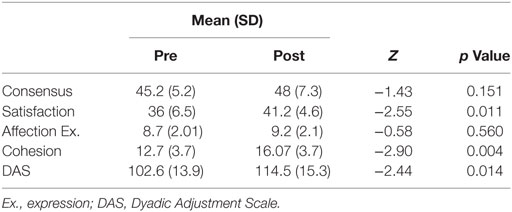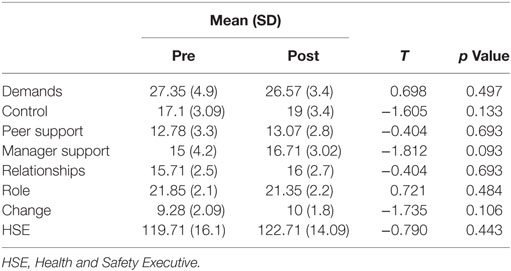Effects of Workplace Parent Management Training on Marital and Job Satisfaction among Iranian Working Parents
- 1Department of Clinical and Health Psychology, Faculty of Psychology, Shahid Beheshti University, Tehran, Iran
- 2Department of Psychology, Islamic Azad University, Central Branch, Tehran, Iran
- 3Islamic Azad University System, Tehran, Iran
Background: Shifting the focus of parent management training (PMT) to parents and discussing implications for maximizing the outcomes of PMT for the entire family is new and promising.
Objective: We aimed to examine the efficacy of work place PMT on job and marital satisfaction among staff members of an academic center.
Methods: We held 8 PMT sessions (1.5 h each) for 20 staff members who were parents to children in the age range of 2–12 years. Dyadic Adjustment Scale (DAS) and Occupational Descriptive Index [Health and Safety Executive (HSE)] were used for baseline and post-intervention data gathering. DAS higher scores indicate higher marital adjustment satisfaction and higher HSE scores indicate higher occupational stress. To analyze changes in HSE and DAS scores over time, paired t-test and Wilcoxon signed rank test were used, respectively.
Results: All DAS subscales show significant increased from baseline to the final session except for affectional expression which was not significant. We found no significant changes in total or subscale HSE scores among participants.
Conclusion: Findings of this study underscore the role of psycho-education usage in work environment and provide evidence about the importance of designing interventions concerning working parents. Implications of PMT are discussed in the text.
Introduction
Training parents is known to be an effective way to change the behavior of their children, one known approach being “parent management training” or PMT (Westrupp et al., 2016). The time children usually spend with their parents and the relationship they have with each other is not comparable to anyone else. Hence, targeting parents in training sessions is considered as a main part of treatment provided for children’s behavioral problems, in specific “externalizing” behavior (Darcy and McCarthy, 2007; Lim and Kim, 2014). This is essentially indirect which means the trainer changes the behavior of the parent which in turn affects that of the child (Mauno et al., 2012). The most common disorder in children that is widely treated with this approach is oppositional defiant disorder and evidence also supports the effectiveness of training on parents whose children suffer from ADHD (Jacobs and Winslow, 2004; Darcy and McCarthy, 2007). There are many studies, however, that show the second hand effects of this procedure on the mental health of the parents and their general well-being. In one study, for instance, researchers found it helpful in treating depression among mothers of referred children (Mauno et al., 2012). PMT is considered to be effective even when conducted remotely and it is approximately as useful as in person (Vieira et al., 2016).
In developed countries, most parents handle two different roles at the same time; the role of looking after their children while also pursuing duties of their jobs. There are fluid boundaries between work and family spheres which is discussed in different schools. Work–family enrichment is positively associated with their involvement in parental role while negative experiences in parenting would indeed influence one’s work negatively. Relationship frustration in the parent–child interactions affect perceived quality of attachment in the parent–child relationship and parenting sense of competence (Vieira et al., 2016). Several studies have investigated the positive and negative impact of work and family on each other. One study suggests that work has negative effects on family since they often compete for limited energy, temporal, and psychological resources (Lim and Kim, 2014). Another study was done for teachers and it was effective in reducing both types of work–family conflict, occupational stress, as well as increasing parental and work-related efficacy and parenting satisfaction (Bögels et al., 2014).
Family systems theory postulates that there is a reciprocal association between functioning in the parental and spousal subsystems. There are many studies supporting this association. In one study, parenting stress has been found to negatively predict marital satisfaction for both fathers and mothers, while marital satisfaction was found to affect individual mental health, family functioning, and child development. In one research, it has been affirmed that parenting stress is a significant negative predictor of marital satisfaction, while parenting self-efficacy and co-parenting alliance are significant positive predictors of marital satisfaction and this applies to both fathers and mothers (Kwan et al., 2015). It has also been affirmed that co-parenting alliance, satisfaction with father involvement, and parenting self-efficacy were significantly and positively correlated with mothers’ marital satisfaction (Kwok et al., 2015). In this paper, we try to show the effects of PMT on two aspects of parents’ lives: the satisfaction of parents as a couple and their contentment in workplace. This indirect intervention has not been investigated systematically in Persian population, so we hypothesized that by enhancing child behavioral issues based on PMT, marital satisfaction will be increased and job stress will be reduced.
Materials and Methods
Setting and Participants
This study was conducted among 20 parents selected from the staff members of the Shahid Beheshti University (main office). The intervention was conducted as an indispensable educational course and was provided by a child and adolescent psychiatrist affiliated with the department of psychology in the Shahid Beheshti university. To meet the inclusion criteria, 20 parents of normal children in the age range of 2–12 years who were living together with the other parent and interested to attend PMT sessions participated in the study. Parents were recruited during a 1-day call in October 2015. Men and women were in the same group and sessions were held from October to December 2015. We invited parents for a baseline session to explain the goals of the study and set dates for an intake interview (session 1), also participant’s rights to privacy considered and written informed consent obtained after careful explanation of the study aims in the baseline introduction session. Our study was in accordance with the ethical standards and Shahid Beheshti ethic committee reviewed and approved this study. Eight sessions (1.5 h each) were designed to meet the purposes of the study. More than three absences from the sessions consider as exclusion criteria in our study. At the end of intervention, just 14 participants found with less than 3 absences. The psychotherapist start most sessions by teaching the group then the topic and participants possible questions discuss and the sessions come to the end by conclusions. It was a closed group and all sessions were held in a conference room located in the department of psychology and details on the provided content in each session are indicated in Table 1.
Measures
We used a two-part questionnaire to measure marital satisfaction and occupational stress; surveys were provided to participants both at baseline (pre-test) and in the last session (post-test).
To measure marital adjustment satisfaction, we utilized the Persian version of Dyadic Adjustment Scale (DAS) (Spanier, 1976; South et al., 2009); that is a widely used 32-item instrument measuring four areas of relationship quality and adjustment: (1) dyadic satisfaction that measures the degree to which respondent feels satisfied with partner, (2) dyadic cohesion; the degree of closeness and shared activities experienced by the couple, (3) dyadic consensus; the degree to which couples agree on matters of importance to their relationship, and (4) affectional expression; the degree to which respondent agrees with partner regarding emotional affection. Previous surveys have shown alpha coefficients ranging from 0.70 (for the 4-item Affectional Expression subscale) to 0.95 (for the 32-item total score; Median = 0.87). Stability coefficients ranged from 0.75 (Affectional Expression) to 0.87 (Total; Median = 0.81). Traditionally, 102 is the cutoff point for DAS score to diagnose distressed couples (Spanier and Thompson, 1982). And higher scores indicate higher marital adjustment satisfaction. A previous study (Hassan shahi, 1999) indicated that this questionnaire has an appropriate internal consistency and an adequate validity for the assessment of marital adjustment satisfaction in Persian sample.
To measure occupational stress, we utilized the Health and Safety Executive (HSE) stress questionnaire that is designed under the supervision of the UK Department for Work Safety (Cousins et al., 2004). This questionnaire is a valid and reliable questionnaire for studying job stress that has been already standardized among Iranian population with a Cronbach’s Alpha ranging from 65 to 75% (Marzabady and Fesharaki, 2011). This questionnaire consists of 35 items and include 7 subscale: “demands,” “control,” “relationships,” “role,” “change,” “managers’ support,” and “peer support.” Higher scores in HSE questionnaire indicate higher occupational stress.
Data Analysis
We analyzed data with Statistical Package for Social Sciences version 22.0 (SPSS vs.22.0, IBM Inc.). Continuous variables were shown in terms of mean (SD) and frequency (number and percentage). To check for possible correlations, we utilized bivariate correlation analysis to compare DAS and HSE scores. To analyze changes in HSE and DAS scores over time, paired t-test and Wilcoxon signed rank test were, respectively, used. Shapiro–Wilk test was used to check for normality of data. Level of significance was considered to be at 0.05.
Results
General Characteristics
From 20 staff members who attended the course, 6 completed less than 3 sessions and were omitted from the list. At the end of last session in post-test, 14 participants filled the questionnaires. Participants consisted of 12 (12/14) women and 2 (2/14) men; with the mean age of 36.14 years (SD = 4.38) and mean work experience of 11.84 years (SD = 3.41). This male to female ratio was consistent with gender distribution among the office staff. All participants had university education: 1/14 with associate degree, 10/14 with bachelor’s and 3/14 with master’s degree.
Correlations
Bivariate correlation analysis indicated that the two main variables of research (DAS and HSE mean scores) had no significant correlations (r = 0.012, p > 0.45). Correlations between two main variable of research and their subscales are shown in Table 2.
Tests of Normality
Based on Shapiro–Wilk test HSE scores showed normal distribution (Sig. = 0.2) but DAS scores did not have a normal distribution (Sig. < 0.041).
DAS Scores
Mean baseline DAS score was reported to be 102.64 (SD = 13.94). At baseline, 35.7% of participants gained scores lower than the cutoff point but in post-test this percentage decreased to 21.4%. Changes in DAS total and subscale scores measured by Wilcoxon signed rank test are shown in Table 3. Unlike the rest of subscales, there was no significant increase from baseline to final session in affectional expression (Z = −0.583, p > 0.05) and dyadic Consensus scores (Z = −1.43, p > 0.05).
HSE Scores
Mean HSE score at baseline was reported to be 119.71 (SD = 16.1). Changes in total and subscale HSE scores are also shown in Table 4. Although “Demands” and “Role” scores had decreased in the final session compared to baseline, none of the scores showed significant difference before and after intervention.
Discussion
Rather than changes in child behavior following PMT, we focused on parents to investigate implications for maximizing treatment effect in the entire family in this study. PMT can be defined as an approach to treating child behavior problems using “procedures in which parents are trained to alter their child’s behavior in the home (McMahon and Wells, 1989).” Marital and job satisfaction were the main outcome variables used to study the intervention effects.
The choice of the two variables was based on a study that indicated the interdependent nature of family and work; stating the fact that experiences in one area affect the quality of life in the other (Sarantakos, 1996). Of relevance, evidence suggests that PMT has been successful in improving marital satisfaction among non-distressed couples (Dadds et al., 1987). In our study, baseline DAS score was borderline; highlighting the appropriate choice of model of training. Previous studies in Iran had shown similar findings with regard to the non-significant correlations between marital satisfaction and job stress (Rahimi et al., 2004; Sori et al., 2006). However, a recent research among flight attendants found positive correlation between job satisfaction and dyadic adjustment (Zamanifar et al., 2016).
We found no significant changes in total or subscale HSE scores in this study. We suggest that the bonus considered by the management may have affected baseline HSE scores. However, we should mention that two subscales scores decreased from baseline to final sessions; this change may be attributed to intervention. Despite the large number of controlled studies attesting the efficacy of PMT fundamental questions remain about the magnitude, scope, and durability of impact (Kazdin, 2006). Marital satisfaction as a main outcome measure to this study was compared to more investigate these unknown areas of effect. Baseline DAS scores were borderline hence participants (working parents) were considered as non-distressed couples; however, their marital situation was not appraised to be satisfactory, not only based on DAS scores but also the observation throughout the intervention. In line with our findings, it is noted that parenting is a huge stress in the modern society especially when the mom works (Kwon, 2011; Kim, 2015).
Comparisons of baseline and post-intervention DAS scores showed significant improvement in the present study that is in line with previous findings (Bögels et al., 2014). All marital satisfaction variables including “consensus,” “satisfaction,” “cohesion,” and DAS total scores had improved; except for “affectional expression” where the increment was not statistically significant. Contrary to our findings, a previous study found significant improvement in affectional expression after a similar intervention for both distressed and non-distressed couples (Eisenberg et al., 2011). We propose cultural differences in expressing affection as a probable explanation. When compared to an emotionally focused couple therapy intervention, different content of the intervention is supposedly the main factor leading to a different outcome in affectional expression scores (Najafi et al., 2015). Although participants had been reassured about anonymity and confidentiality of their responses, we assume privacy may have been a concern to affect affectional expression scores.
Our findings should be considered in light of few limitations. First, shifting the focus of PMT to parents and discussing implications for maximizing the outcomes of PMT for the entire family was almost new and our study conducted without significant previous literature in this specific area. Second, measuring occupational stress by self-report questionnaire in participants work environment may cause bias in responding (as found in this study). Third, randomize sampling was not feasible and the sample was very low not only because of small number of university staff but also cause of exclusion criteria. It was a primary step to target marital satisfaction by applying PMT. Further research may conduct by a larger sample and randomize sampling, so results can be generalized to a large group of parents in need for intervention.
“This research is sponsored by Shahid Beheshti University, department of health and clinical psychology.”
Author Contributions
The main idea and intervention of this research carried on by MM, but RA did the statistical analyze and other works like article writing.
Conflict of Interest Statement
The authors declare that the research was conducted in the absence of any commercial or financial relationships that could be construed as a potential conflict of interest.
Funding
Shahid Beheshti University provided the publication cost.
References
Bögels, S. M., Hellemans, J., Deursen, S. V., Römer, M., and Meulen, R. V. (2014). Mindful parenting in mental health care: effects on parental and child psychopathology, parental stress, parenting, co-parenting, and marital functioning. Mindfulness (N Y) 5, 536–551. doi: 10.1007/s12671-013-0209-7
Cousins, R., MacKay, C. J., Clarke, S. D., Kelly, C., and Kelly, P. J. (2004). Management standards and work related stress in the UK: practical development. Work Stress 18, 113–136. doi:10.1080/02678370410001734322
Dadds, M., Schwartz, S., and Sanders, M. (1987). Marital discord and treatment outcome in behavioral treatment of child conduct disorders. J. Consult. Clin. Psychol. 55, 396–403. doi:10.1037/0022-006X.55.3.396
Darcy, C., and McCarthy, A. (2007). Work-family conflict: an exploration of the differential effects of a dependent child’s age on working parents. J. Eur. Ind. Train. 31, 53–549. doi:10.1108/03090590710820042
Eisenberg, S. D., Peluso, P. R., and Schindler, R. A. (2011). Impact of Brief Marriage and Relationship Education Classes on Dyadic Adjustment. Available from: www.Pairs.com/PDF/MRE_Dyadic_Adjustment.pdf
Hassan, S. M. (1999). Relation of Married Compatibility to Center of Women′s Control. Ms thesis, Esfahan University, Esfahan. [in Persian].
Jacobs, J. A., and Winslow, S. (2004). Overworked faculty: job stresses and family demands. Ann. Am. Acad. 596, 104–129. doi:10.1177/0002716204268185
Kazdin, A. E. (2006). Parent management training: evidence, outcomes, and issues. J. Am. Acad. Child Adolesc. Psychiatry 36, 1349–1356. doi:10.1097/00004583-199710000-00016
Kim, A. (2015). Study on the effect of working mom’s conflict between job and nurturing on parenting stress – focus on mediating effect of core competence in nurturing. Indian J. Sci. Technol. 8, 1–6. doi:10.17485/ijst/2015/v8i26/81177
Kwan, R. W. H., Kwok, S. Y. C. L., and Ling, C. C. Y. (2015). The moderating roles of parenting self-efficacy and co-parenting alliance on marital satisfaction among Chinese fathers and mothers. J. Child Fam. Stud. 2, 3506–3515. doi:10.1007/s10826-015-0152-4
Kwok, S. Y. C. L., Cheng, L., Chow, B. W. Y., and Ling, C. C. Y. (2015). The spillover effect of parenting on marital satisfaction among Chinese mothers. J. Child Fam. Stud. 24, 772–783. doi:10.1007/s10826-013-9888-x
Kwon, M. K. (2011). Analysis of trends in research on parenting stresses. J. Korean Home Manag. Assoc. 29, 39–50.
Lim, V. K. G., and Kim, T. Y. (2014). The long arm of the job: parents’ work-family conflict and youths’ work centrality. Appl. Psychol. Int. Rev. 63, 151–167. doi:10.1111/j.1464-0597.2012.00527.x
Marzabady, A., and Fesharaki, G. M. (2011). Reliability and validity assessment for the HSE job stress questionnaire. J. Behav. Sci. 4, 291–297.
Mauno, S., Kinnunen, U., and Feldt, T. (2012). Work-family culture and job satisfaction: does gender and parenting status alter the relationship? Community Work Fam. 15, 101–129. doi:10.1080/13668803.2011.598733
McMahon, R. J., and Wells, K. C. (1989). “Conduct disorders,” in Treatment of Childhood Disorders, eds E. J. Mash and R. A. Barkley (New York: Guilford) p. 73–132.
Najafi, M., Soleimani, A. A., Ahmadi, K., Javidi, N., Hoseini Kamkar, E., and Pirjavid, F. (2015). The study of the effectiveness of couple emotionally focused therapy (EFT) on increasing marital adjustment and improving the physical and psychological health of the infertile couples. IJOGI 17, 8–21.
Rahimi, A., Ahmadi, F., and Akhond, M. R. (2004). Evaluation of factors influencing occupational stress of nurses in some hospitals in Tehran. Hayat J. 10, 13–22.
Sori, H., Rahimi, M., and Mohseni, H. (2006). Epidemiological pattern of occupational stress in managers in the automobile industry group. Gilan Univ. Med. Sci. J. 15, 26–35.
South, S. C., Krueger, R. F., and Iacono, W. G. (2009). Factor structure of the Dyadic Adjustment Scale: confirmatory analyses and invariance across gender. Psychol. Assess. 21, 622–628. doi:10.1037/a0017572
Spanier, G. B. (1976). Measuring dyadic adjustment: new scales for assessing the quality of marriage and similar dyads. J. Marriage Fam. 38, 15–28. doi:10.2307/350547
Spanier, G. B., and Thompson, L. A. (1982). A confirmatory factor analysis of the Dyadic Adjustment Scale. J. Marriage Fam. 44, 731–738. doi:10.2307/351593
Vieira, J. M., Matias, M., Lopez, F. G., and Matos, P. M. (2016). Relationships between work-family dynamics and parenting experiences: a dyadic analysis of dual-earner couples. Work Stress 30, 243–261. doi:10.1080/02678373.2016.1211772
Westrupp, E. M., Strazdins, L., Martin, A., Cooklin, A., Zubrick, S. R., and Nicholson, J. M. (2016). Maternal work-family conflict and psychological distress: reciprocal relationships over 8 years. J. Marriage Fam. 78, 107–126. doi:10.1111/jomf.12262
Keywords: parent management training, marital satisfaction, job satisfaction, Iranian working parents, PMT
Citation: Mousavi M, Alavinezhad R and Moosavi A (2017) Effects of Workplace Parent Management Training on Marital and Job Satisfaction among Iranian Working Parents. Front. Sociol. 2:19. doi: 10.3389/fsoc.2017.00019
Received: 28 July 2017; Accepted: 06 November 2017;
Published: 23 November 2017
Edited by:
Meichun Mohler-Kuo, University of Zurich, SwitzerlandReviewed by:
Costin Roventa, Hospital Prof. Dr. Al. Obregia, RomaniaJude Uzoma Ohaeri, University of Nigeria, Nigeria
Copyright: © 2017 Mousavi, Alavinezhad and Moosavi. This is an open-access article distributed under the terms of the Creative Commons Attribution License (CC BY). The use, distribution or reproduction in other forums is permitted, provided the original author(s) or licensor are credited and that the original publication in this journal is cited, in accordance with accepted academic practice. No use, distribution or reproduction is permitted which does not comply with these terms.
*Correspondence: Ramin Alavinezhad, raminalavinezhad@yahoo.com
 Masoumeh Mousavi1
Masoumeh Mousavi1
 Ramin Alavinezhad
Ramin Alavinezhad


